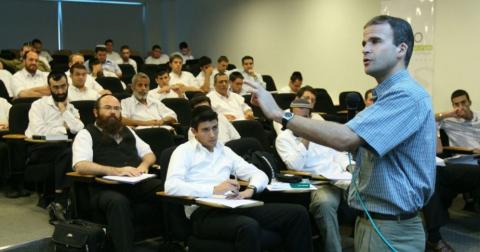Report: ultra-Orthodox Israelis receive secular education
Changes in the situation in the ultra-Orthodox community could potentially have a significant impact on the country and its economy due to the communitys high birthrate and the generally low workplace participation rate among ultra-Orthodox men, where at least in the past, the norm was to engage in full-time religious study as adults rather than engaging in full-time employment.
Economists have pointed to the low workplace participation rates of ultra-Orthodox men – and Arab Israeli women – as a major loss to the Israeli economy. The picture is changing, however. Since 2002, the proportion of adult ultra-Orthodox males who are employed has jumped from 35% to 52%. Among women, the rate went from 50% to 73%. But between 2015 and 2016 the increased workplace participation stalled.
It is assumed that current government policy, which has decreased the incentives to join the workforce and increased support for adult males engaged in religious study, is part of reason. Nevertheless, polling data on attitudes towards work reveal that younger adult respondents attach greater importance to advancement in the workplace than their older ultra-Orthodox peers. Interestingly, 96% of ultra-Orthodox respondents said they had never experienced workplace discrimination as a result of their adherence to ultra-Orthodoxy.
According to the report, the countrys ultra-Orthodox or Haredi, population, as it is known in Hebrew, hit a million in 2017 for the first time, meaning that Haredi Israelis constitute 12% of the countrys population. That figure is projected to rise to 16% by 2030 and 33% in 2065, at which point Haredim are forecast to constitute 40% of the countrys Jewish population due to their high birthrates. Those birthrates, however, are declining.
In 2003, the average ultra-Orthodox woman had 7.5 children. The figure has declined to 6.9, but it is still vastly higher than the 2.4 children among non-Haredi Jewish Israeli women today. Fully 82% of the ultra-Orthodox population over the age of 20 are married, compared to 63% among other Jewish Israelis. That being said, the average age at which Haredim are getting married is on the rise.
The ultra-Orthodox community is young compared to the Jewish population as a whole. Fifty-eight percent of the Haredim in Israel are 19 years old or younger, compared to 30% of the Jewish population in general. There are about 300,000 children in Haredi schools around the country, representing 18% of the countrys school population, but the rate of growth of the number of students in the ultra-Orthodox school system declined by a quarter between 2003 and 2016, from 4.2% a year to 3.2%.
Interestingly, during the same period, the annual pace of growth in the state school system went from 0.5% to 2.3%. Two possible explanations for the surprising difference are the decline in the Haredi birthrate and a possible decline in the attractiveness of ultra-Orthodox schools among families that are not fervently ultra-Orthodox.
When it comes to the rate at which high school students in Haredi schools are taking matriculation exams, there is a stark gender divide. The overall rate rose from 23% in 2005 to 33% in 2015, but thats in large measure because the rate among girls jumped from 31% to 51%. Among boys, it actually dropped – from 16% in 2009 to 13% in 2015.
The number of Haredi students enrolled in Israeli institutions of higher education – universities and colleges – jumped, astoundingly, tenfold, from 1,000 to 10,800 – and 69% of them are women. Haredi students disproportionately study education and para-medical professions.
The average monthly income in Haredi households is 12,616 shekels ($3,636), which is about 35% less than the average among the countrys non-Haredi Jewish households.
Tali Heruti-Sover

